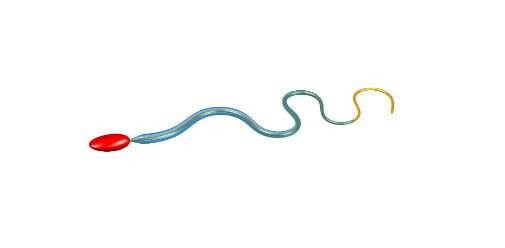Mathematicians reveal secret to human sperm's swimming prowess

Researchers have discovered what gives human sperm the strength to succeed in the race to fertilise the egg.
The researchers, from the universities of York and Oxford, discovered that a reinforcing outer-layer which coats the tails of human sperm is what gives them the strength to make the powerful rhythmic strokes needed to break through the cervical mucus barrier.
Only around 15 out of the 55 million sperm that embark on the treacherous journey to fertilise the egg are able to make it through the reproductive tract where cervical mucus, which is one hundred times thicker than water, forms part of one of nature's toughest selective challenges.
The findings could lead to better sperm-selection methods in IVF clinics, with the fittest sperm being identified under conditions that mimic nature more closely.
3.5 million people in the UK are affected by fertility issues and couples who opt for IVF spend an average of £20,000.
Dr. Hermes Gadêlha, from the Department of Mathematics at the University of York, said: "We still don't fully understand how, but a sperm's ability to swim could be associated with genetic integrity. Cervical mucus forms part of the process in the female body of ensuring only the best swimmers make it to the egg.
"During the sperm selection process, IVF clinics don't currently use a highly viscous liquid to test for the best sperm as until now it was not entirely clear whether this is important. Our study suggests that more clinical tests and research are needed to explore the impact of this element of the natural environment when selecting sperm for IVF treatments."
Sperm tails—or flagella—are incredibly complex and measure just the breadth of a hair in length.
The researchers used virtual sperm model to compare the tails of sperm from humans and other mammals, which fertilise inside the body; with sperm from sea urchins, which fertilize outside the body by releasing their sperm into sea water.
While the tails of sea urchin and human sperm share the same bendy inner core, the study suggests that the tails of sperm in mammals may have evolved a reinforcing outer layer to give them the exact amount of extra strength and stability required to overcome the thick fluid barrier they come up against in internal fertilisation.
The researchers used virtual models to add and remove the features of flagella in the different species so that they could identify their function.
They tested the ability of virtual sea urchin-like sperm to swim through liquid as viscous as cervical mucus and found that their tails quickly buckled under the pressure, rendering them unable to propel themselves forward.
Human sperm on the other hand, thrashed around wildly in a low-viscosity liquid like water, but in thicker liquids they began to swim in a powerful rhythmic wave.
Dr. Gadêlha added: "Using virtual sperm we were able to see how mammalian sperm is specially adapted to swim through thicker fluids. We don't know which adaptation came first—the stronger sperm or the cervical mucus, or whether they co-evolved—but nothing in nature is by chance and precisely what is required for species to reproduce has been added due to evolutionary pressure over millions of years."
With no central nervous system to make decisions about how to move and when—what controls sperms movement remains a scientific mystery.
"We know that, just like in our arms and legs, sperm have tiny muscles which allow their tails to bend— but nobody knows how this is orchestrated inside the tail, at the nanometric scale," said Dr. Gadêlha.
"Sperm are an architype of self-organisation—movement seems to be happening automatically, perhaps because of a complex combination of many mechanisms at play."
More information: Flagellar ultrastructure suppresses buckling instabilities and enables mammalian sperm navigation in high viscosity media, Journal of the Royal Society Interface, rsif.royalsocietypublishing.or … .1098/rsif.2018.0668
Journal information: Journal of the Royal Society Interface
Provided by University of York





















